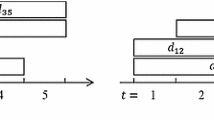Abstract
We present deterministic model formulations for the capacitated lot-sizing problem, including service-level constraints that address both the periodic and cyclic \(\alpha \) service levels, as well as the \(\beta \), \(\gamma \), and \(\eta \) service levels. We assume that service levels for individual products are given and controlled over a given reporting period (i.e., one year). These deterministic model formulations may be used when all data are deterministic and decision makers intend to exploit given service levels to minimize setup and holding costs. A further application is to provide lower bounds for capacitated lot-sizing problems with stochastic demand and given service-level constraints. In contrast to well-known stochastic or robust optimization approaches, there are new proposals in the literature that do not require scenario modeling and thus have much greater potential for use in solving (large-scale) real-world production planning problems. However, an evaluation of the quality of solutions resulting from these new approaches is difficult. For this purpose, lower bounds showing the best possible (ideal) solution should be of great help. In a computational study, we provide insight into the computational efforts associated with deterministic model formulations with service-level constraints. Finally, lower bounds generated by the deterministic model with \(\beta \) service-level constraints are compared with the results of a rolling schedule strategy addressing a stochastic lot-sizing problem with given \(\beta \) service-level constraints. The resultant difference in the objective function values (costs) defines the uncertainty gap. We demonstrate its increase with forecast inaccuracy as well as machine utilization.





Similar content being viewed by others
Notes
Bonus payments are calculated in advance and provided as data (Meistering and Stadtler 2017)
References
Billington PJ, McClain JO, Thomas LJ (1983) Mathematical programming approaches to capacity-constrained MRP systems: review, formulations and problem reduction. Manag Sci 29(10):1126–1141
Bitran GR, Yanasse HH (1982) Computational complexity of the capacitated lot size problem. Manag Sci 28(10):1174–1186
Bloomberg D, LeMay S, Hanna J (2002) Logistics. Pearson Education, London
Carlson R, Beckman S, Kropp D (1982) The effectiveness of extending the horizon in rolling production scheduling. Decis Sci 13:129–146
Chand S, Sethi SP, Sorger G (1992) Forecast horizons in the discounted dynamic lot size model. Manag Sci 38(7):1034–1048
Christopher M (2005) Logistics and supply chain management: creating value-adding networks. Financial times series. FT Prentice Hall, Upper Saddle River
De Filippo A, Lombardi M, Milano M, Borghetti A (2018) Off-line/on-line optimization under uncertainty. In: Cashmore M, Cire AA, Piacentini C (eds) PlansOpt 2018, Proceedings of the 3rd workshop on planning, search and optimization, 28th international conference on automated planning and scheduling, June 24–29, Delft, the Netherlands, pp 10–18
Eppen GD, Martin RK (1987) Solving multi-item capacitated lot-sizing problems using variable redefinition. Oper Res 35(6):832–848
Federgruen A, Tzur M (1994) Minimal forecast horizons and a new planning procedure for the general dynamic lot sizing model: nervousness revisited. Oper Res 42(3):456–468
Fisher M, Ramdas K, Zheng Y (2001) Ending inventory valuation in multiperiod production scheduling. Manag Sci 47(5):679–692
Gade D, Küçükyavuz S (2013) Formulations for dynamic lot sizing with service levels. Nav Res Logist 60(2):87–101
Groff G (1979) A lot sizing rule for the time-phased component demand. Prod Inventory Manag 20(19):47–53
Hilger TJ (2015) Stochastic dynamic lot-sizing in supply chains. Books on Demand, Norderstedt
Jans R, Degraeve Z (2008) Modeling industrial lot sizing problems: a review. Int J Prod Res 46(6):1619–1643
Karimi B, Fatemi Ghomi S, Wilson J (2003) The capacitated lot sizing problem: a review of models and algorithms. Omega 31(5):365–378
Krarup J, Bilde O (1977) Plant location set covering and economic lot size: an o(mn)-algorithm for structured problems. In: Collatz L, Meinardus G, Wetterling W (eds) Numerische methoden bei optimierungsaufgaben, vol 3. Birkhäuser, Basel, pp 155–186
Meistering M, Stadtler H (2017) Stabilized-cycle strategy for capacitated lot sizing with multiple products: fill-rate constraints in rolling schedules. Prod Oper Manag 26(12):2247–2265
Pochet Y, Wolsey LA (1988) Lot-size models with backlogging: strong reformulations and cutting planes. Math Program 40(1–3):317–335
Pochet Y, Wolsey LA (2006) Production planning by mixed integer programming. Springer, New York
Silver EA, Pyke DF, Peterson R (1998) Inventory management and production planning and scheduling, vol 3. Wiley, New York
Song JS, Zipkin P (2003) Supply chain operations: assemble-to-order systems. In: de Kok A, Graves S (eds) Supply chain management: design, coordination and operation, handbooks in OR & MS, vol 11. Elsevier, Amsterdam, pp 561–596
Sridharan V, LaForge RL (1994) Freezing the master production schedule: implications for fill rate. Decis Sci 25(3):461–469
Stadtler H (2000) Improved rolling schedules for the dynamic single-level lot-sizing problem. Manag Sci 46(2):318–326
Stadtler H (2003) Multi-level lot sizing with setup times and multiple constrained resources: internally rolling schedules with lot-sizing windows. Oper Res 51(3):487–502
Stadtler H, Fleischmann B (2012) Hierarchical planning and the supply chain planning matrix. In: Stadtler H, Fleischmann B, Grunow M, Meyr H, Sürie C (eds) Advanced planning in supply chains. Springer, Berlin, pp 21–34
Tempelmeier H (2011) Inventory management in supply networks: problems, models, solutions. Books on Demand, Norderstedt
Tempelmeier H, Derstroff M (1996) A lagrangean-based heuristic for dynamic multilevel multiitem constrained lot sizing with setup times. Manag Sci 42(5):735–757
Tempelmeier H, Fischer L (2010) Approximation of the probability distribution of the customer waiting time under an (r, s, q) inventory policy in discrete time. Int J Prod Res 48(21):6275–6291
Thomas DJ (2005) Measuring item fill-rate performance in a finite horizon. Manuf Serv Oper Manag 7(1):74–80
Van Den Heuvel W, Wagelmans A (2005) A comparison of methods for lot-sizing in a rolling horizon environment. Oper Res Lett 33(5):486–496
Xie J, Zhao X, Lee TS (2003) Freezing the master production schedule under single resource constraint and demand uncertainty. Int J Prod Econ 83(1):65–84
Zangwill WI (1966) A deterministic multi-period production scheduling model with backlogging. Manag Sci 13(1):105–119
Author information
Authors and Affiliations
Corresponding author
Additional information
Publisher's Note
Springer Nature remains neutral with regard to jurisdictional claims in published maps and institutional affiliations.
Rights and permissions
About this article
Cite this article
Stadtler, H., Meistering, M. Model formulations for the capacitated lot-sizing problem with service-level constraints. OR Spectrum 41, 1025–1056 (2019). https://doi.org/10.1007/s00291-019-00552-1
Received:
Accepted:
Published:
Issue Date:
DOI: https://doi.org/10.1007/s00291-019-00552-1




